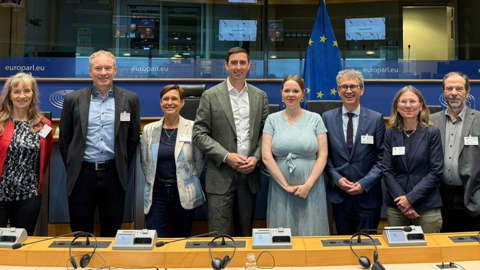Skogforsk in the European Parliament: "Proper forest management contributes to climate goals"

This recommendation was given by Skogforsk in the European Parliament recently.
The recommendation is one of three presented in the Policy Brief Potential and limits of European forests in climate mitigation, recently written by Skogforsk and its counterparts in Norway (NIBIO), Austria (BFW), Finland (LUKE), and Slovenia (Slovenian Forestry Institute).
In its entirety, the brief shows that Europe’s forest carbon sink is weakening, which is a known fact. New forest inventories point to reduced growth, increased soil emissions, and growing pressure from drought, pests, and forest fires.
Three recommendations
Therefore, the report authors give three clear recommendations to policymakers connected to Europe’s forests:
- Set climate targets for forests that are realistic and measurable, taking into account natural variation and climate uncertainties.
- Provide stronger incentives for forest management that ensures long-term carbon storage in both forests and wood products, as well as resilient forests.
- Recognize the role of forest soils in climate policy. They store more carbon than the trees themselves.
The recommendation on how forests should be managed long-term was presented by Skogforsk’s CEO, Charlotte Bengtsson. She urged policymakers to provide forest owners with increased support, guidance, and clear incentives to implement effective, practical management measures.
- Forest management actions must be adapted to the conditions of the specific site. It’s not possible to give recommendations that apply equally to all European countries. And smart forest management can provide a ‘double benefit’: increased carbon storage both in the forest and in wood products. At the same time, Europe’s forests will be better equipped to withstand the effects of climate change, said Charlotte Bengtsson.
She emphasized the benefits of robust, improved seedlings adapted to future climate and raw material needs, as well as mixed forests with multiple tree species to reduce vulnerability. At the same time, she noted that it takes time to see results from forest management actions.
- Forest owners therefore need to be given time to think long-term, said Charlotte Bengtsson.
Must be based on science
According to the EU’s legislation for land use, land-use change, and forestry (LULUCF), the forest sector must sequester 310 million tonnes of CO₂ equivalents per year by 2030. But the report authors warn that the targets may become unrealistic if policy is not based on scientific facts and backed by sufficient resources.
The Policy Brief concludes that forests remain a central part of the EU’s climate efforts and the goal of climate neutrality by 2050 – but only if strategies take ecological limitations into account and actively support sustainable forestry in practice.